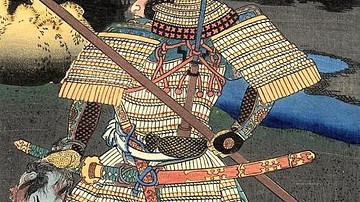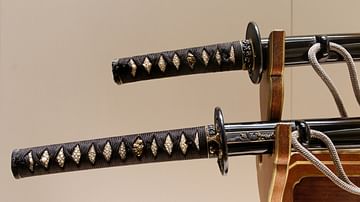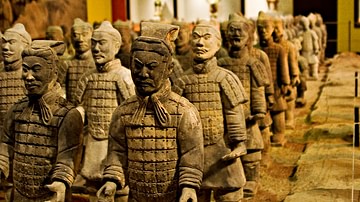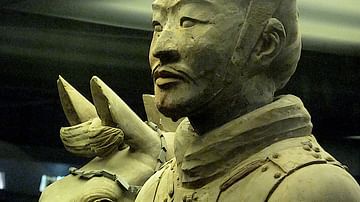Although the bow and crossbow were the weapons of choice for much of China's history, the sword played its part, especially when warriors were forced to dismount and face the enemy at close quarters. Widely used from around 500 BCE, swords were first made of bronze, then iron and eventually steel, undergoing various developments in design to improve their weight, cutting edge, and durability.
Bronze Age Swords
Most historians agree that bronze daggers, short swords, and long spearheads were used long before swords and that the true sword (typically defined as a weapon with a blade which is at least twice the length of the handle) did not commonly appear on the Chinese battlefield until the Spring and Autumn period (722-479 BCE). However, some historians maintain bronze swords were in use in the Western Zhou period (1046-771 BCE). Nevertheless, in Chinese tradition, the invention of the sword was even earlier and credited to the legendary Yellow Emperor.
Chariots were a staple feature of ancient Chinese armies and the weapons best suited to a more mobile warfare where the enemy was kept at a certain distance were the bow, crossbow, and halberd (a cross between a spear and an axe). Only when chariots began to be replaced by larger infantry armies did the sword become a more valuable asset to soldiers. This was because swords wielded from a chariot cab had only a limited striking range and exposed the soldier to stabbing from spears.
It may be, though, that the increase in sword use had more to do with improved metalworking techniques than anything else as even when chariots were present on the Chinese battlefield there were still huge numbers of infantry and these presumably preferred more traditional weapons to a sword which, at that time, had a high possibility of shattering. The point is here summarised by the military historian R. D. Sawyer,
The sword's thrusting ability was clearly approximated by the short hand spear, essentially a dagger point mounted on a handle, and a preference for traditional weapons coupled with technical difficulties in making strong yet resilient swords more likely retarded the sword's emergence as a critical weapon…swords with slashing power and significant blade length simply could not be fabricated until the Spring and Autumn period, and even then would not flourish until the late Warring States and Han dynasty. (Sawyer, 2017, 271)
Perhaps for these reasons - tradition and technical deficiencies - the sword, when it did appear on the battlefield, was usually left in the scabbard and used only as a weapon of last resort. A depiction of a battle in a late Spring and Autumn tomb significantly shows opposing soldiers battling each other with spears and halberds while their swords remain in their belts. It is also true that Chinese warfare tended to avoid the toe-to-toe with the enemy scenarios that were typical in, say, the hoplite battles of ancient Greece, and commanders preferred, instead, to engage the enemy from a distance using archers and then if need be with spearmen.
During the 6th century BCE, things were beginning to change and the Wu and Yueh used and developed the sword, "to such a high degree that they were famous throughout the realm; when unearthed today, they still retain their surface and edge qualities" (Sawyer, 2007, 365). One of the earliest battles where the use of the sword was a significant contribution to victory was in 520 BCE when the army of the Qin state defeated a Hua army by charging on foot with their swords instead of the usual halberds.
Warring States Period Swords
The earliest Chinese swords were, then, very long, necessitated both hands to wield and were designed not for cutting and slashing but as a weapon to stab and thrust at the enemy, just as halberds and spears had been used earlier. Indeed, the sword may have evolved not from foreign influence but from the indigenous habit of using long spearheads like stabbing swords. With the rise in the use of cavalry from the final stages of the Warring States period (3rd century BCE), a sword with the better cutting possibilities of a double edge and a less cumbersome blade became desirable. Although there is a story that King Chen (future Qin dynasty emperor Shi Huangdi) had problems dealing with an assassin in 227 BCE because he could not draw his longsword quick enough.
By now made with iron, another development was to coat the sword blade's core with a chromium alloy to produce a sharper edge. Experimentation with pommels also gave the sword a much better balance. Another innovation was a change in the handle shape to an asymmetrical form which stopped it swivelling in the hand. The same result was achieved by adding one or two moulded rings to the handle or a cord wrap for extra grip. When not in use the blade was kept in a scabbard of leather or lacquered wood and hung from a waist belt.
The terrible wounds that swords could inflict - much more shocking and gruesome than arrows - is evidenced in references in military literature. For example, in this extract from T'ai Kung's 3rd-century BCE Six Secret Teachings:
Within the army there will be men with great courage and strength who are willing to die and even take pleasure in suffering wounds. They should be assembled into a company and called “Warriors Who Risk the Naked Blade”.
(Sawyer, 2007, 97)
The greater use of swords in battles necessitated improvements in armour from the 3rd century BCE. Previously body armour had been made of only hardened or lacquered leather, but now it was increasingly common to add pieces of metal to afford better protection. These additions took the form of small iron or bronze plates either pierced and stitched together or riveted. Helmets and shields also improved to help meet the deadly threat of a stabbing and slashing swordsman.
Han Dynasty Swords
In the Han period (206 BCE - 220 CE) and beyond, metalworking techniques improved, which made swords lighter yet more durable with an even sharper blade made of stronger iron than previously. The design also changed to better suit the use of the weapon by cavalry - only one cutting edge was made and a ring added to protect the hand. There is a tendency towards shorter blades with surviving examples from the 3rd century CE having a blade of around 45 cm (18 inches) in length. Although there are other types still with a very long blade - around one metre (42 inches) in length, indicating that the evolution of the sword was far from straightforward in China and traditional weapons, it seems, were only very reluctantly melted down and recast. Further evidence of this parallel use of varying designs of weapons is seen in the eclectic collections found in tombs.
Another feature of the Han period was the popularity of sword experts who could not only measure the strength and usefulness of a particular weapon but who also claimed they could assess more mystical qualities such as the sword's auspiciousness. That such experts were believed and consulted is attested by the profuse Han literature on the subject.
Later Swords
Swords were still very much in use by the Tang period (618-907 CE) where blades became even shorter and were made of steel. There was, too, the development of another version of the weapon, the elaborately decorated ceremonial sword which often had silk-wrapped handles and jade inlay, which was kept in an even more sumptuously decorated silk-lined scabbard inlaid with precious metals and jewels.
Swordsmanship and a general fascination with swords would become even more popular in the medieval period with the development of martial arts, their symbolic use in Taoist rituals, and even a collectorship of swords which became a popular pursuit by Chinese literati. Swords and their expert handlers were regularly eulogised in poems and literature. Right up to the 19th century CE there were all types of swords still in use - straight blades, curved blades, thin, long and short blades, wicked-looking sabres, swords with elegantly curved handles, and even scabbards that held two swords, one for each hand. The history of swords in China is a tremendously long one, and they have, as in other East Asian cultures, captured people's imagination, both ancient and modern, like no other weapon.








